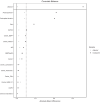Prehospital norepinephrine administration reduces 30-day mortality among septic shock patients
- PMID: 35387608
- PMCID: PMC8988327
- DOI: 10.1186/s12879-022-07337-y
Prehospital norepinephrine administration reduces 30-day mortality among septic shock patients
Abstract
Background: Despite differences in time of sepsis recognition, recent studies support that early initiation of norepinephrine in patients with septic shock (SS) improves outcome without an increase in adverse effects. This study aims to investigate the relationship between 30-day mortality in patients with SS and prehospital norepinephrine infusion in order to reach a mean blood pressure (MAP) > 65 mmHg at the end of the prehospital stage.
Methods: From April 06th, 2016 to December 31th, 2020, patients with SS requiring prehospital Mobile Intensive Care Unit intervention (MICU) were retrospectively analysed. To consider cofounders, the propensity score method was used to assess the relationship between prehospital norepinephrine administration in order to reach a MAP > 65 mmHg at the end of the prehospital stage and 30-day mortality.
Results: Four hundred and seventy-eight patients were retrospectively analysed, among which 309 patients (65%) were male. The mean age was 69 ± 15 years. Pulmonary, digestive, and urinary infections were suspected among 44%, 24% and 17% patients, respectively. One third of patients (n = 143) received prehospital norepinephrine administration with a median dose of 1.0 [0.5-2.0] mg h-1, among which 84 (69%) were alive and 38 (31%) were deceased on day 30 after hospital-admission. 30-day overall mortality was 30%. Cox regression analysis after the propensity score showed a significant association between prehospital norepinephrine administration and 30-day mortality, with an adjusted hazard ratio of 0.42 [0.25-0.70], p < 10-3. Multivariate logistic regression of IPTW retrieved a significant decrease of 30-day mortality among the prehospital norepinephrine group: ORa = 0.75 [0.70-0.79], p < 10-3.
Conclusion: In this study, we report that prehospital norepinephrine infusion in order to reach a MAP > 65 mmHg at the end of the prehospital stage is associated with a decrease in 30-day mortality in patients with SS cared for by a MICU in the prehospital setting. Further prospective studies are needed to confirm that very early norepinephrine infusion decreases septic shock mortality.
Keywords: Early; Mortality; Norepinephrine; Prehospital setting; Septic shock.
© 2022. The Author(s).
Conflict of interest statement
None of the author.
Figures


References
-
- Fleischmann C, Scherag A, Adhikari NK, Hartog CS, Tsaganos T, Schlattmann P, et al. Assessment of global incidence and mortality of hospital-treated. Sepsis current estimates and limitations. Am J Respir Crit Care Med. 2016;193(3):259–272. - PubMed
-
- Gaieski DF, Edwards JM, Kallan MJ, Carr BG. Benchmarking the incidence and mortality of severe sepsis in the United States. Crit Care Med. 2013;41(5):1167–1174. - PubMed
-
- Martin GS, Mannino DM, Eaton S, Moss M. The epidemiology of sepsis in the United States from 1979 through 2000. N Engl J Med. 2003;348(16):1546–1554. - PubMed
MeSH terms
Substances
LinkOut - more resources
Full Text Sources
Medical
Miscellaneous

